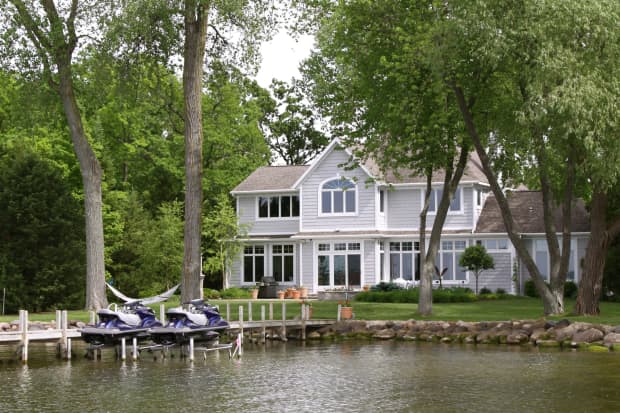This post was originally published on this site

An increasing number of vacation-home buyers want safety, they want to distance themselves from strangers and they want enough space to entertain family and friends.
Getty Images/iStockphoto
This article is reprinted by permission from The Escape Home, a newsletter for second homeowners and those who want to be. Subscribe here. © 2020. All rights reserved.
In the world of waterfront living, the nation has long been divided into two distinct groups: ocean people and lake people.
Ocean communities have often won the popularity contest. They are a mecca for trendy urbanites attracted to the therapeutic sounds of the crashing waves, the wide sandy beaches and indulgent social life. Lake communities, in contrast, offer still waters where residents can reflect and lead a quiet, yet active, country life.
But perceptions are shifting and the nation’s lakes and ponds are becoming more popular with all types of families. It’s just one more way that the COVID-19 crisis is reshaping the way we live. An increasing number of vacation-home buyers want safety, they want to distance themselves from strangers and they want enough space to entertain family and friends.
Avoiding sharks is also in the equation.
Vacasa, the home-rental management company, found that the number of searches on its website for “lakefront vacation rentals” were three to four times higher this past summer than in the past.
Scott Freerksen, owner of Lakefront Living Realty in Mansfield, Mass., has been selling vacation homes to buyers from Boston, New York and Providence since 2003. He said he’s “never seen so much interest in lakefront as this year. A lot of the activity is pandemic related.’’ Many of his buyers are looking in the lake region of New Hampshire, which includes Lake Merrymeeting and Squam Lake, where the movie “On Golden Pond” was filmed. Unlike beach towns, where prices for a fixer-upper can start at $500,000, Freerksen says a fixer-upper on a lake can start at half that price.
“’Sanctuary’ is the word people are using to describe the property they’re seeking,” said Nicole Watkins at Berkshire Hathaway HomeServices Verani Realty in Moultonborough, N.H. “People want to socialize outdoors with extended family instead of flying somewhere,” said Watkins, who specializes in the sale of waterfront properties on Lake Winnipesaukee. She said lake homes in her region are often located on larger lots than you’d typically find in beach towns, providing space for pools, outdoor living rooms, gazebos and guest houses.
There’s also a growing perception, based on the new era of social distancing, that beaches have become too congested. “Some buyers are saying that beach towns are too dense. And when you go to the beach, it’s too crowded,” said Glenn Phillips, chief executive of Lake Homes Realty in Hoover, Ala. Traffic on his website has tripled since May, with what he called “feeding frenzy” activity from people looking at properties in the Finger Lakes region of upstate New York. “The lake is not dense and you have more things to do and you’re not around a lot of other people. You can play in the lake, you can go boating on the lake,” or kayaking and waterskiing. There’s also hiking in the woods.
Lake communities aren’t as crowded as beach towns in part because there are so many of them, both natural and man-made. It’s hard to get an exact figure on the total number of lakes in the U.S., but most agree there are hundreds of thousands of them. States with lots of lakes like to brag about it. In the northeast, New York has one of the highest counts with over 7,000 lakes, Maine, Massachusetts and Connecticut boast of having 3,000, New Jersey has over 1,000.
Of course, the large majority of those lakes aren’t habitable or large enough for residential development. Many are located in public parks that are off limits to development. But that still leaves thousands of communities from which buyers can choose.
When searching for a lakefront home in the Northeast, most buyers start with the largest and most popular lakes, including Lake George in New York, Candlewood in Connecticut and Wallenpaupack in Pennsylvania. But if buyers don’t see what they want or can afford, they start looking at the less well-known lakes.
Even before the COVID-19 crisis, Americans’ love affair with the ocean was starting to diminish — albeit just a tad —due to concerns about climate change. Real estate agents said pre-pandemic, the two main reasons why beach people were turning into lake people were hurricanes and insurance costs.
As hurricane activity has picked up, the cost of flood insurance has risen sharply everywhere, but far more in locations near the sea. Hurricanes are less likely to wreak extensive havoc on inland lakes, although homeowners can expect some damage from downed trees. And the potential for flooding is less severe because lake water levels on most lakes are controlled by some type of inlet and outlet system or by dams. That doesn’t mean lakes are immune to severe weather — just that the damage can be less extensive.
But lakes have other problems. They suffer periodically from toxic algae blooms that can shut down water activities for weeks or months. Considering the short summer seasons in the Northeast, that can be a hardship for some families. Recently, the state of New Hampshire issued a warning about cyanobacteria blooms in several lakes and New Jersey prohibited swimming in Lake Hopatcong due to harmful algal blooms.
Lake lovers argue that there are so many other things to do in lake communities that shutting down water activities isn’t the end of the world. Literally, the naysayers can go … take a hike.
This article is reprinted by permission from The Escape Home, a newsletter for second homeowners and those who want to be. Subscribe here. © 2020. All rights reserved.

